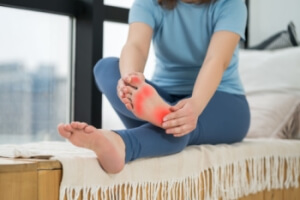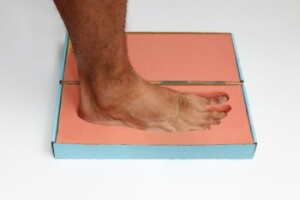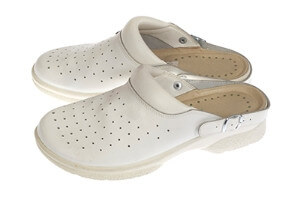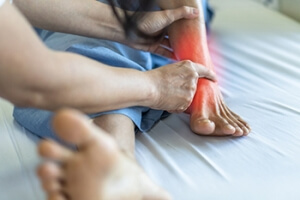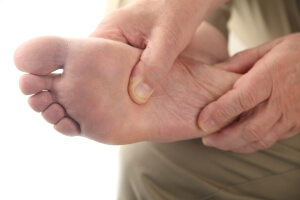Super User
Investing in Custom Orthotics Means Investing in Foot Health
Custom orthotics offer a tailored approach to foot health, providing a host of benefits that extend far beyond conventional shoe inserts. One of the primary advantages lies in their ability to address specific biomechanical issues. Unlike off-the-shelf inserts, custom orthotics are crafted based on an individual's unique foot structure, gait, and any existing foot conditions.
The personalized design of custom orthotics ensures optimal support for the arches, promoting proper alignment and distributing pressure evenly across the feet. This can be particularly beneficial for individuals dealing with issues such as overpronation or underpronation, as custom orthotics help correct imbalances that may lead to discomfort or injury.
Beyond biomechanics, custom orthotics can alleviate a range of foot problems, including plantar fasciitis, bunions, and metatarsalgia. They provide targeted relief to areas under stress, reducing pain and inflammation. Additionally, for those with specific medical conditions like diabetes, custom orthotics can play a crucial role in preventing complications associated with poor foot health.
Comfort is another key aspect of custom orthotics. By accommodating the unique contours of an individual's feet, these inserts enhance overall comfort, making daily activities more enjoyable. Whether for athletes looking to optimize performance or individuals seeking relief from chronic foot pain, custom orthotics offer a versatile solution.
Investing in custom orthotics is an investment in long-term foot health. They not only provide immediate relief but also contribute to the prevention of future issues. With the ability to seamlessly integrate into various types of footwear, custom orthotics empower individuals to prioritize foot comfort without compromising on style. In essence, custom orthotics are a personalized prescription for happy, healthy, and pain-free feet.
Understanding Foot Changes During Pregnancy

Pregnancy is a transformative journey marked by numerous bodily changes, including those affecting the feet. As the body undergoes hormonal shifts and weight gain, the feet bear the brunt of these transformations, often resulting in the development of various foot conditions. Swelling, or edema, is a common occurrence due to fluid retention, causing the feet to appear puffy and uncomfortable. Additionally, the increased pressure on the arches may lead to the onset or exacerbation of conditions such as plantar fasciitis or flat feet. Hormonal changes can also impact ligaments and joints, potentially causing instability and discomfort in the ankles and feet. To mitigate these issues, pregnant individuals are advised to wear supportive footwear, elevate their feet when possible, and engage in gentle exercises to improve circulation and alleviate swelling. If you have developed foot conditions during your pregnancy, it is suggested that you schedule an appointment with a podiatrist who can guide you toward finding relief.
Pregnant women with swollen feet can be treated with a variety of different methods that are readily available. For more information about other cures for swollen feet during pregnancy, consult with one of our podiatrists from New Tampa Foot & Ankle. Our doctors will attend to all of your foot and ankle needs.
What Foot Problems Can Arise During Pregnancy?
One problem that can occur is overpronation, which occurs when the arch of the foot flattens and tends to roll inward. This can cause pain and discomfort in your heels while you’re walking or even just standing up, trying to support your baby.
Another problem is edema, or swelling in the extremities. This often affects the feet during pregnancy but tends to occur in the later stages.
How Can I Keep My Feet Healthy During Pregnancy?
- Wearing orthotics can provide extra support for the feet and help distribute weight evenly
- Minimize the amount of time spent walking barefoot
- Wear shoes with good arch support
- Wear shoes that allow for good circulation to the feet
- Elevate feet if you experience swelling
- Massage your feet
- Get regular, light exercise, such as walking, to promote blood circulation to the feet
If you have any questions please feel free to contact our office located in Wesley Chapel, FL . We offer the newest diagnostic and treatment technologies for all your foot and ankle needs.
Common Symptoms and Causes of Plantar Fasciitis
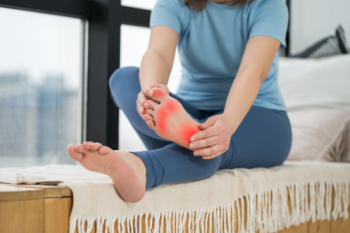
Plantar fasciitis causes pain in the heel and the bottom of the foot, particularly during the first steps in the morning. This condition occurs when the plantar fascia, a thick band of tissue connecting the heel bone to the toes, becomes inflamed or strained. The primary symptom is sharp, stabbing pain near the heel, especially after long periods of standing or intense physical activity. The causes of plantar fasciitis include excessive strain on the feet, high-impact activities, flat feet, or wearing non-supportive shoes. Obesity, tight calf muscles, and aging can also increase the risk. Addressing the underlying causes through proper footwear, stretching exercises, and weight management, are vital steps in managing plantar fasciitis. If you have heel pain, it is suggested that you consult a podiatrist who can accurately diagnose plantar fasciitis and offer correct treatment options.
Plantar fasciitis can be very painful and inconvenient. If you are experiencing heel pain or symptoms of plantar fasciitis, contact one of our podiatrists from New Tampa Foot & Ankle. Our doctors can provide the care you need to keep you pain-free and on your feet.
What Is Plantar Fasciitis?
Plantar fasciitis is the inflammation of the thick band of tissue that runs along the bottom of your foot, known as the plantar fascia, and causes mild to severe heel pain.
What Causes Plantar Fasciitis?
- Excessive running
- Non-supportive shoes
- Overpronation
- Repeated stretching and tearing of the plantar fascia
How Can It Be Treated?
- Conservative measures – anti-inflammatories, ice packs, stretching exercises, physical therapy, orthotic devices
- Shockwave therapy – sound waves are sent to the affected area to facilitate healing and are usually used for chronic cases of plantar fasciitis
- Surgery – usually only used as a last resort when all else fails. The plantar fascia can be surgically detached from the heel
While very treatable, plantar fasciitis is definitely not something that should be ignored. Especially in severe cases, speaking to your doctor right away is highly recommended to avoid complications and severe heel pain. Your podiatrist can work with you to provide the appropriate treatment options tailored to your condition.
If you have any questions please feel free to contact our office located in Wesley Chapel, FL . We offer the newest diagnostic and treatment technologies for all your foot and ankle needs.
Myths About Custom Orthotics
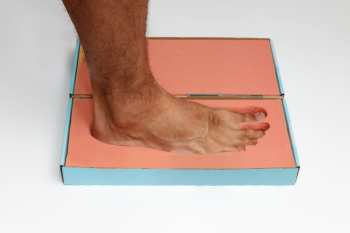
Custom foot orthoses have a rich history, dating back to the mid-19th century when Lewis Durlacher created molded leather devices to address foot issues for Queen Victoria. Over the years, several myths have emerged about the function and effects of custom orthoses. First, custom orthotics are personalized medical devices designed to optimize foot and lower extremity function by modifying ground reaction forces' timing, location, and magnitude. They do not force the foot into specific joint positions but work with their unique morphology, stiffness, and cushioning properties to achieve therapeutic goals. Custom foot orthoses serve various purposes, from relieving diabetic neuropathic ulcers to reducing tension stress in conditions like plantar fasciitis. They also redirect ground reaction forces to prevent bending moments responsible for stress fractures and other issues. That there is one best way to design custom orthoses is another myth. The flexibility of custom orthoses allows for tailored solutions for different pathologies. Lastly, the notion that custom foot orthoses weaken feet over time lacks scientific backing. In fact, research suggests that they can enhance foot muscle activation. If you would like to understand more about how custom orthotics might help you, it is suggested that you make an appointment with a podiatrist.
If you’re experiencing foot discomfort, have a history of foot and ankle injuries, or are interested in exploring Custom orthotics, don’t hesitate to contact one of our podiatrists at New Tampa Foot & Ankle. Our doctors is dedicated to offering the care required to help you remain pain-free and stay on your feet.
What are Custom Orthotics?
Custom orthotics refer to custom inserts designed for placement in different shoe types, including athletic and formal footwear, with the purpose of alleviating a spectrum of foot-related problems such as flat feet, heel pain, and overall foot discomfort. These inserts are instrumental in providing relief and comfort for a diverse range of foot conditions, including heel pain, and can also act as a proactive approach to injury prevention.
Medical Grade Shoe Inserts:
A diverse array of shoe inserts is available for addressing foot pain, heel discomfort, and minor issues. For instance, you can place arch supports in your shoes to rectify overarched or flat feet, and gel and cushioned insoles are frequently chosen for the comfort and relief they provide from foot and heel pain by reducing pressure.
If you have any questions please contact our office located in Wesley Chapel, FL . We offer the newest diagnostic and treatment technologies for all your foot and ankle needs.
Investing in Custom Orthotics Means Investing in Foot Health
Custom orthotics offer a tailored approach to foot health, providing a host of benefits that extend far beyond conventional shoe inserts. One of the primary advantages lies in their ability to address specific biomechanical issues. Unlike off-the-shelf inserts, custom orthotics are crafted based on an individual's unique foot structure, gait, and any existing foot conditions.
The personalized design of custom orthotics ensures optimal support for the arches, promoting proper alignment and distributing pressure evenly across the feet. This can be particularly beneficial for individuals dealing with issues such as overpronation or underpronation, as custom orthotics help correct imbalances that may lead to discomfort or injury.
Beyond biomechanics, custom orthotics can alleviate a range of foot problems, including plantar fasciitis, bunions, and metatarsalgia. They provide targeted relief to areas under stress, reducing pain and inflammation. Additionally, for those with specific medical conditions like diabetes, custom orthotics can play a crucial role in preventing complications associated with poor foot health.
Comfort is another key aspect of custom orthotics. By accommodating the unique contours of an individual's feet, these inserts enhance overall comfort, making daily activities more enjoyable. Whether for athletes looking to optimize performance or individuals seeking relief from chronic foot pain, custom orthotics offer a versatile solution.
Investing in custom orthotics is an investment in long-term foot health. They not only provide immediate relief but also contribute to the prevention of future issues. With the ability to seamlessly integrate into various types of footwear, custom orthotics empower individuals to prioritize foot comfort without compromising on style. In essence, custom orthotics are a personalized prescription for happy, healthy, and pain-free feet.
Choosing Appropriate Footwear for Restaurant Workers
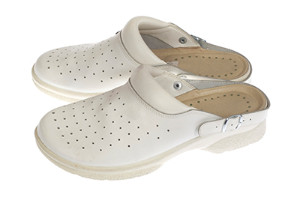
Selecting the right shoes for restaurant employees is paramount, considering the unique demands of the hospitality industry. Restaurant staff, who often spend long hours on their feet, require comfortable and supportive footwear to navigate the dynamic environment effectively. Slip-resistant shoes are essential, minimizing the risk of accidents in busy kitchens and dining areas. Opt for closed-toe styles to provide additional protection and prevent spills or sharp objects from causing harm. Comfort is key, so shoes with cushioning and arch support help alleviate the stress on the feet during extended shifts. Furthermore, choosing shoes made from breathable materials can enhance comfort and reduce the likelihood of foot-related issues. By investing in appropriate footwear, restaurant employees not only prioritize their foot health but also contribute to a safer and more efficient working environment. If you are working at a restaurant, it is suggested that you confer with a podiatrist who can provide you with specific information on the type of shoes to purchase.
While working on the feet, it is important to take the proper care of them. For more information about working on your feet, contact one of our podiatrists from New Tampa Foot & Ankle. Our doctors will treat your foot and ankle needs.
Working on Your Feet
Standing on your feet for long periods of time can cause stress and pain in your feet. Your whole body may experience change in terms of posture, back pain, bunions, callouses and or plantar warts. There are ways to avoid these conditions with proper foot care, smart choices and correct posture.
Positive Changes
Negative heeled shoe – Choosing this shoe type places the heel slightly lower than the ball of the foot. These are great for overall foot health. Find shoes that fit you correctly.
Go barefoot – Our feet were not designed to be enclosed for all hours of the day. Try to periodically expose your feet to air.
Eliminate Pain
Foot Exercises – Performing simple exercises, incorporating yoga and doing stretches are beneficial. This will allow increased blood flow to the area and muscles of the foot.
Achilles tendon – Stretching the foot out flat on the floor will relax the calf muscles and tendon. These exercises can be performed almost anywhere. Make sure you add these exercises to your daily regimen.
With a little bit of this information and knowing more about foot health, you will notice changes. Foot stretches and proper footwear will help with pain and prevent further issues.
If you have any questions please feel free to contact our office located in Wesley Chapel, FL . We offer the newest diagnostic and treatment technologies for all your foot and ankle needs.
How to Handle a Long Work Day on Your Feet
In 2014, the American Podiatric Medical Association surveyed 1,000 American adults and found that half of all respondents lived with foot pain. Fortunately, there are ways to avoid foot problems such as following a daily footcare routine and wearing proper footwear at work.
If you have a job that requires you to be on your feet, it is best that you do not wear flat sole shoes. Your heel should be slightly elevated (less than 2 inches, but at least ¼-inch) if you are going to be standing for a prolonged period. You should also make sure that the shoes you wear are not too small. Tight shoes may cut off circulation to your feet, which will result in pain and blisters. It is always best to purchase fitted shoes later in the day, because the feet tend to swell as the day progresses. It may also be helpful to buy shoes a half size larger if you plan on wearing custom orthotics or arch supports.
Your muscles may become stiff when you are constantly standing up. It is important to take breaks every hour to stretch and relax. One tip is to perform calf raises, because this exercise will help improve your circulation. To perform this stretch, you first need to stand on the edge of a step with your abdominal muscles pulled inward. You then need to grip the step with the balls of your feet with your heels hanging over the edge. Next, try to raise your heels above the step by a few inches while standing on your tiptoes; hold this pose for a second. You should then lower your heels back even to the platform. These calf raises should be done ten times for full effectiveness.
You should also take care of your feet while you are at home. One of the best ways to prepare your feet for a long day of work is to soak them in ice water. Doing so for 20 minutes will help fight the swelling and inflammation that results from being on your feet at work.
Nevertheless, if you are experiencing pain in your feet, you should seek help from your podiatrist. Your doctor will help treat any ailments you may have in addition to helping you prevent any other ailments from developing in the future.
Stretches for the Toes
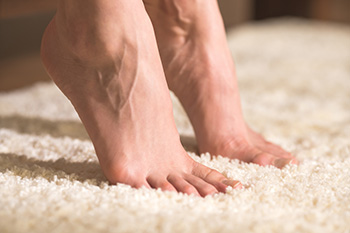
You can enhance your foot health with simple toe stretches that promote flexibility and reduce the risk of injuries. These exercises are designed to increase blood flow, helping to relieve pain and swelling. Whether you are targeting general foot health or addressing a specific condition, like bunions, these stretches are a valuable addition to your daily foot health routine. Start with the toe lift stretch, where you sit with your feet flat on the floor, lifting your toes to the same height for five seconds before lowering. Repeat 10 times on each foot, gradually increasing repetitions. Next, the toe lift and spread can be done seated, lifting your toes and spreading them apart for added resistance. Use a rubber band for increased difficulty and repeat 10 times on each foot. For the toe flex stretch, stand with feet shoulder-width apart, using a wall for support. Flex the toes of one foot against the wall for five seconds, repeating 10 times on each foot while using your hands for stability. Finally, the big toe pull stretch involves sitting with feet flat on the floor, wrapping a towel or belt around your big toe. Pull the towel toward you while resisting with your foot for five seconds. Repeat 10 times on each foot to promote mobility and flexibility. If you are experiencing toe pain that worsens, it is suggested that you schedule an appointment with a podiatrist for an exam.
Exercising your feet regularly with the proper foot wear is a great way to prevent injuries and build strength. If you have any concerns about your feet, contact one of our podiatrists from New Tampa Foot & Ankle. Our doctors can provide the care you need to keep you pain-free and on your feet.
Exercise for Your Feet
Exercise for your feet can help you gain strength, mobility and flexibility in your feet. They say that strengthening your feet can be just as rewarding as strengthening another part of the body. Your feet are very important, and we often forget about them in our daily tasks. But it is because of our feet that are we able to get going and do what we need to. For those of us fortunate enough to not have any foot problems, it is an important gesture to take care of them to ensure good health in the long run.
Some foot health exercises can include ankle pumps, tip-toeing, toe rises, lifting off the floor doing reps and sets, and flexing the toes. It is best to speak with Our doctors to determine an appropriate regimen for your needs. Everyone’s needs and bodies are different, and the activities required to maintain strength in the feet vary from individual to individual.
Once you get into a routine of doing regular exercise, you may notice a difference in your feet and how strong they may become.
If you have any questions please feel free to contact our office located in Wesley Chapel, FL . We offer the newest diagnostic and treatment technologies for all your foot and ankle needs.
Common Causes of Ankle Pain
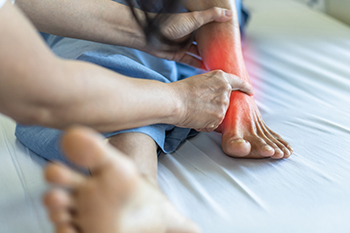
Ankle pain, a prevalent discomfort that can hinder mobility, stems from various underlying factors. One frequent culprit is sprained ligaments, often resulting from sudden twists or awkward movements that strain the ankle beyond its normal range. Tendonitis, inflammation of the tendons surrounding the ankle joint, also can cause persistent pain, especially with movement. Arthritis, a condition marked by joint inflammation, can affect the ankle, resulting in discomfort and stiffness. Fractures, often the result of impact or trauma, can cause sharp and localized pain. Additionally, overuse injuries, stemming from repetitive stress on the ankle, may lead to chronic discomfort. Certain conditions, such as gout or infections, can contribute to ankle pain. Understanding these diverse causes is pivotal for effective intervention and management. If you are experiencing ankle pain, it is strongly suggested that you consult a podiatrist who can determine what the cause is, and offer appropriate relief and treatment remedies.
Ankle pain can have many different causes and the pain may potentially be serious. If you have ankle pain, consult with one of our podiatrists from New Tampa Foot & Ankle. Our doctors will assess your condition and provide you with quality foot and ankle treatment.
Ankle pain is any condition that causes pain in the ankle. Due to the fact that the ankle consists of tendons, muscles, bones, and ligaments, ankle pain can come from a number of different conditions.
Causes
The most common causes of ankle pain include:
- Types of arthritis (rheumatoid, osteoarthritis, and gout)
- Ankle sprains
- Broken ankles
- Achilles tendinitis
- Achilles tendon rupture
- Stress fractures
- Tarsal tunnel syndrome
- Plantar fasciitis
Symptoms
Symptoms of ankle injury vary based upon the condition. Pain may include general pain and discomfort, swelling, aching, redness, bruising, burning or stabbing sensations, and/or loss of sensation.
Diagnosis
Due to the wide variety of potential causes of ankle pain, podiatrists will utilize a number of different methods to properly diagnose ankle pain. This can include asking for personal and family medical histories and of any recent injuries. Further diagnosis may include sensation tests, a physical examination, and potentially x-rays or other imaging tests.
Treatment
Just as the range of causes varies widely, so do treatments. Some more common treatments are rest, ice packs, keeping pressure off the foot, orthotics and braces, medication for inflammation and pain, and surgery.
If you have any questions, please feel free to contact our office located in Wesley Chapel, FL . We offer the newest diagnostic and treatment technologies for all your foot care needs.
Early Indicators of Foot Problems in Diabetic Patients
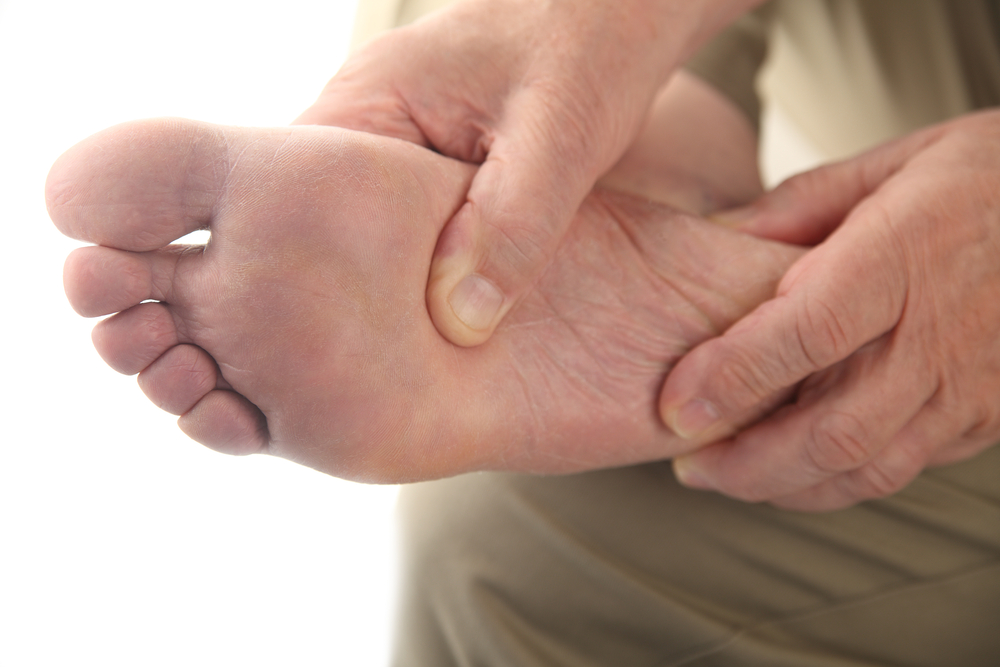
People with diabetes are at a higher risk of developing serious foot problems, which can ultimately lead to amputation if not addressed promptly. This is especially true if they are considered to have a high risk of foot issues. Monitoring your feet daily is crucial if you fall into this category. It is essential to be aware of signs such as tingling, pain, shiny skin, and loss of feeling. Additional symptoms can include swelling, lack of sweat, slow healing wounds, and blisters or cuts that you cannot feel. If you have diabetes and notice signs of foot problems, it is strongly suggested that you make an appointment with a podiatrist who will assess your risk level, create a personalized care plan, and provide appropriate treatment for existing foot conditions.
Diabetic foot care is important in preventing foot ailments such as ulcers. If you are suffering from diabetes or have any other concerns about your feet, contact one of our podiatrists from New Tampa Foot & Ankle. Our doctors can provide the care you need to keep you pain-free and on your feet.
Diabetic Foot Care
Diabetes affects millions of people every year. The condition can damage blood vessels in many parts of the body, especially the feet. Because of this, taking care of your feet is essential if you have diabetes, and having a podiatrist help monitor your foot health is highly recommended.
The Importance of Caring for Your Feet
- Routinely inspect your feet for bruises or sores.
- Wear socks that fit your feet comfortably.
- Wear comfortable shoes that provide adequate support.
Patients with diabetes should have their doctor monitor their blood levels, as blood sugar levels play such a huge role in diabetic care. Monitoring these levels on a regular basis is highly advised.
It is always best to inform your healthcare professional of any concerns you may have regarding your feet, especially for diabetic patients. Early treatment and routine foot examinations are keys to maintaining proper health, especially because severe complications can arise if proper treatment is not applied.
If you have any questions please feel free to contact our office located in Wesley Chapel, FL . We offer the newest diagnostic and treatment technologies for all your foot and ankle needs.

